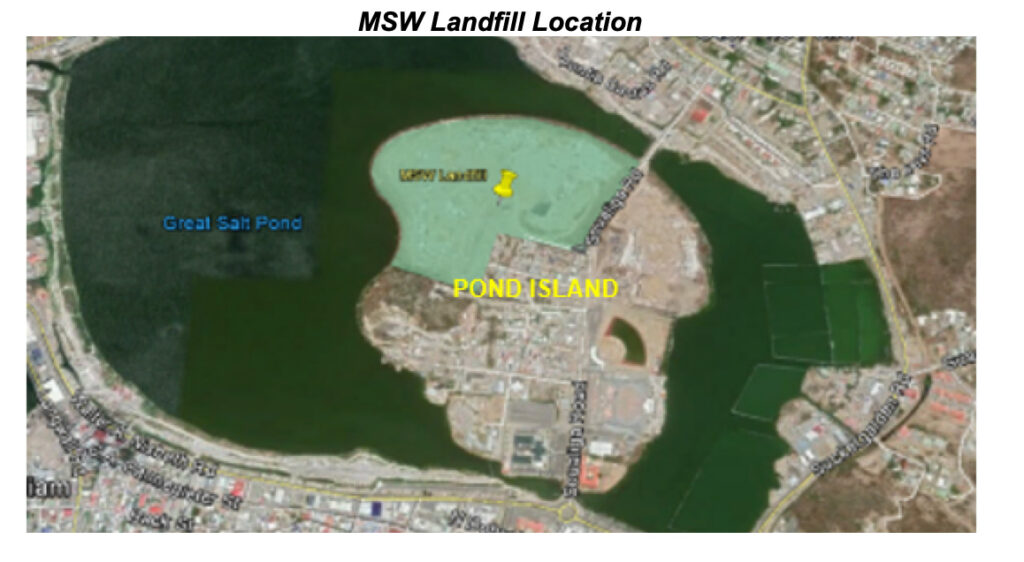Washington, World Bank, February 22, 2020 (Sint Maarten)
Aim Texas Consultants’ Sint Maarten ISWMS development team has completed and submitted the Final Feasibility Studies and Short-Term Plan incorporated with the comments and suggestions in the workshops held in 22nd of January, 2020 in Sint Maarten.
Feasibility Study 1: MSW Landfill Upgrading & Extension
This Feasibility Study (FS 1) examined the design, operations management, improvement, re-contouring, and eventual closure and aftercare of the existing MSW landfill including fire suppression activities during management of the main MSW landfill of Sint Maarten, and available area as part of the government-owned property allocated to solid waste at Pond Island of Sint Maarten.

As part of improving the site, slope stability and maintenance of fire suppression activities are considered as part of improved operational plan. This study also included a preliminary assessment giving recommendations on project’s environmental & social impact during the phases of the project.
Feasibility 1 – MSW Landfill Upgrading and Extension
This Feasibility Study (FS 1) examined the design, operations management, improvement, re-contouring, and eventual closure and aftercare of the existing MSW landfill including fire suppression activities during management of the main MSW landfill, and available area as part of the government-owned property allocated to solid waste at Pond Island of Sint Maarten.
The entire property available for Pond Island MSW landfill has been considered for potential disposal, taking into account the adjacent land use practices in Pond Island. According to the results of drone surveys conducted in 2019, approximately 150,000 cubic meters waste is disposed to the landfill last year. The volume corresponds to approximately 110K – 120K tons of waste per year, including C&D waste, yard waste from area cleaning activities, household waste, commercial waste, WEEE, industrial and institutional waste. The waste accepting capacity has been projected for landfill life extension, and a 3-D model is developed with three slope alternatives. The model assumed that all special waste types will be diverted to another area to be dedicated by the government within the fourth quarter of 2020, and MSW landfill will not accept the special waste types to reduce the volume demand in the landfill, as the landfill capacity is limited. The model also assumes that the MSW landfill will be closed at the end of 2027 – 2008.
The model assumed that the net height of the waste pile would be 35 – 36-m, with topsoil cover 37-m.

The calculated remaining volume seems to extend the lifetime of the landfill by 7-8 years (approx. to the 2028) with all measures recommended in this report would be implemented within the next 1 -2 years. The calculated remaining volume may increase in time as the waste to be placed will be compacted adequately with suitable and sufficient equipment, and re-placing of the waste during re-contouring activities and compaction of new waste will rise the compaction efficiency of the waste pile already placed.
Feasibility 2 – Integrated Solid Waste Management Facility (ISWMF) of Sint Maarten
The Feasibility Study 2 on Integrated Solid Waste Management Facility (ISWMF) described the proposed works and contract arrangements, and the viability of locating all the needed operations at the current available properties owned by government at the Pond Island. The report discussed the initial capacity of the plant to handle MSW and discuss the potential requirements if ship waste were later included in an expansion. For follow-up work, the Consultant provided short descriptions for each proposed package of work for the next steps of feasibility studies, costs, siting, and other activities needed to advance the development of ISWMF.
The ISWMF and its weighbridges would be the heart of Sint Maarten’s solid waste system. All collection and any related source segregation activities would need to support the facility. Contracts, licenses, and regulations of both waste generators and collectors that are needed to be upgraded to enable the facility to be successful. Aside from describing the legal/regulatory/contractual requirements needed, packages have been outlined with costs to describe the next work activities that would advance progress on this aspect.
The ISWMF is expected to have three basic modules of operation, namely:
- A materials recovery sorting module
- A putrescible organics decomposition module, and
- A waste to energy module.
Because of the limited land disposal capacity in Sint Maarten, it has been recommended that the waste to energy module include special treatment of residues, so that they can be recycled. Waste to energy typically reduces volume by 85-90% and weight by 20-25%…which means there is residue that could require disposal space if not further processed. The residual ash, slag, and/or pollution control residues would ideally be processed to the extent possible to minimize disposal. This comes at a relatively high cost, but the cost needs to be weighed relative to the lack of suitable land for disposal.
Based on the estimated waste characterization shown in the Short-Term Plan, it is estimated that the lines of treatment would include the following:Conversion of ash and slag to usable products.

The layout will depend on the final property boundaries that the Government is able to set aside for construction of the treatment facility and related residuals disposal. It would have a planted buffer zone around the security wall.
The following is a concept layout for the whole facility. As seen in the concept plan there should be a passageway between MRF part and WTE part. This passageway should large enough to provide easy passing the vehicles to WTE part. However, each part of ISWMF should have access to a main transportation route.
